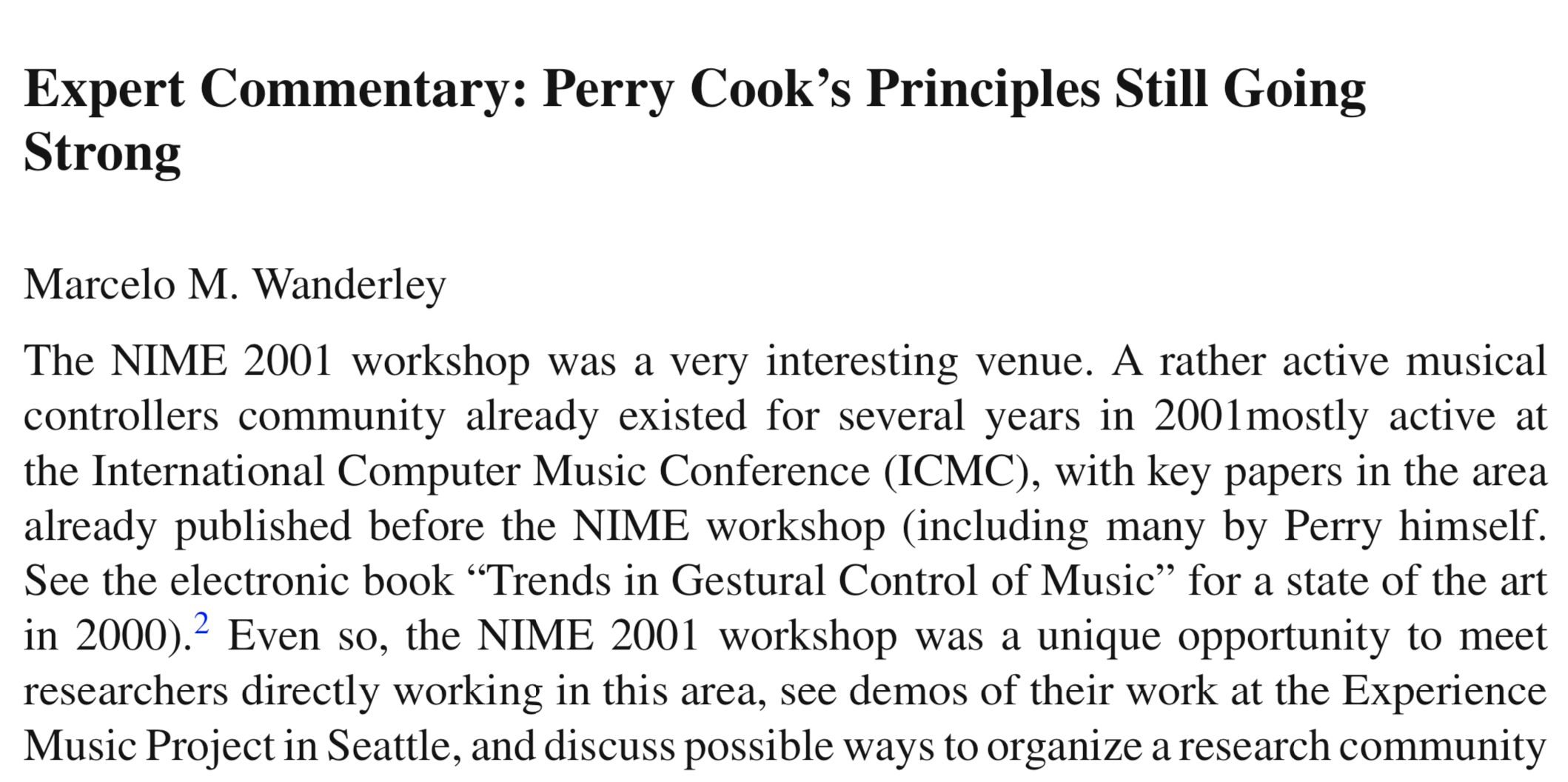Authors:
Marcelo M. WanderleyPublication or Conference Title:
A NIME Reader: Fifteen Years of New Interfaces for Musical ExpressionEditors:
Alexander Refsum Jensenius, Michael J. LyonsAbstract:
The NIME 2001 workshop was a very interesting venue. A rather active musical controllers community already existed for several years in 2001mostly active at the International Computer Music Conference (ICMC), with key papers in the area already published before the NIME workshop (including many by Perry himself. See the electronic book “Trends in Gestural Control of Music” for a state of the art in 2000).
Even so, the NIME 2001 workshop was a unique opportunity to meet researchers directly working in this area, see demos of their work at the Experience Music Project in Seattle, and discuss possible ways to organize a research community around it. Several of the papers presented in the workshop became main references in our field, with several hundred citations each: Perry’s, Wessel’s and Wright’s (2001) and Orio et al.’s (2001), the two last ones with sequels published in the 2002 Computer Music Journal special edition (vol. 26, number 3) on NIME.
It was very interesting to re-read Perry Cook’s 2001 NIME workshop paper, as well as its NIME 2009 follow up paper where he reviews the original 2001 guidelines in light of newer developments. Perry’s 2001 paper belongs to a tradition of works from builders/performers (or performer/builders) who excel in both areas. Such works have the advantage of bringing to the community lots of personal, first hand performance experience informed by a strong technical/scientific component. In this sense, it is complementary to works by designers who mostly focus on technical aspects, who nevertheless collaborate with (multiple) artists when designing their devices. The advantage of the later group is that one can (hopefully!) more easily avoid one’s own aesthetic ideas about music and art and provide a larger, albeit forcefully less coherent, set of examples from which to derive guidelines. The study of both approaches, taking into consideration their own strengths and limitations, should lead to interesting (and informed!) designs.
It is amazing to see that in almost 15 years, many (most?) of its principles and guidelines still hold true. My favorites are (#4) “Some players have spare bandwidth, some do not” (true, how true!), (#2) “Smart instruments are often not smart,” (#1) “Programmability is a curse,” and (#6) “Instant music, subtlety later.” The last one ties well to Wessel and Wright’s principle: “Low entry fee, with no ceiling on virtuosity” (Wessel and Wright 2001).
Being part of the group who focuses mostly on technical issues (an example of a great paper about design is Bongers (2000)), I am less in agreement with principle #5 (“Make a piece, not an instrument or controller”), as I have seen many interesting instruments made without a musical piece in mind, but that subsequently were exten- sively used musically. The case in mind is Joe Malloch’s t-Stick (Malloch and Wanderley 2007), who in collaboration with composer/performer D. Andrew Stewart, developed a device that became an established instrument used in dozens of musical pieces (check Andrew’s impressive t-stick performance videos at vimeo.com).
I also take principles #10 and #11 (“New algorithms suggest new controllers” and “New controllers suggest new algorithms”) with a grain of salt, as I believe that they underplay the idea importance of mapping (between controller outputs and algorithm inputs). Complex mapping strategies can provide tools to use a variety of algorithms with the same controller (e.g. Hunt et al. (2002)), leading to interesting instruments. Furthermore, not all instrument designers are proficient in sound design and might just want to use algorithms they are familiar with, even when using different controllers (and conversely).
Finally, other principles seem to have become less useful with time, as for instance, battery life that has dramatically improved in the last 15 years (#8), making the use of cables is less necessary in instrument design (although still useful in many occasions!) (#9). In short, this is still a very useful, inspiring paper. Perry’s direct style is excellent and the review of his previous works until then is enlightening. Some of its principles will hold for a long time (forever?) and have become basic bricks to our community.
References:
Bongers, B. (2000). Physical interfaces in the electronic arts. Interaction theory and interfacing techniques for real-time performance. In M. Wanderley, & M. Battier (Eds.), Trends in Gestural Control of Music. IRCAM—Centre Pompidou, Paris.
Hunt, A., Wanderley, M. M., & Paradis, M. (2002). The importance of parameter mapping in electronic instrument design. Proceedings of the International Conference on New Interfaces for Musical Expression (pp. 149–154). Dublin, Ireland.
Malloch, J., & Wanderley, M. M. (2007). The T-Stick: From musical interface to musical instrument. In Proceedings of the International Conference on New Interfaces for Musical Expression (pp.
66–69). New York, NY.
Orio, N., Schnell, N., & Wanderley, M. M. (2001). Input devices for musical expression: Borrowing tools from HCI. In Proceedings of the International Conference on New Interfaces for Musical
Expression. Seattle, WA: ACM SIGCHI.
Wessel, D., & Wright, M. (2001). Problems and prospects for intimate musical control of computers. In Proceedings of the International Conference on New Interfaces for Musical Expression. Seattle,
WA: SigCHI.
Publication Details:
Type: |
Book Section |
Date: |
01/01/2017 |
Pages: |
11-13 |
DOI: |
10.1007/978-3-319-47214-0 |
ISBN: |
978-3-319-47213-3 |
ISSN: |
2196-6966 |

